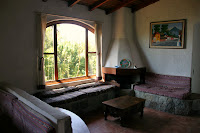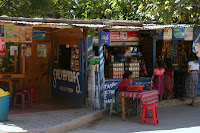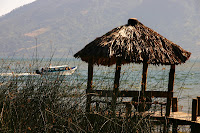 We typically awaken at dawn and from our kitchen and living room we gaze at the gorgeous body of water that Aldus Huxley called, “The most beautiful lake in the world.” We enjoy coffee either from the lofty ver
We typically awaken at dawn and from our kitchen and living room we gaze at the gorgeous body of water that Aldus Huxley called, “The most beautiful lake in the world.” We enjoy coffee either from the lofty ver anda of our Mediterranean style home or from our bedroom, which offers a different view of the mountain peaks to the west. Days are warm and sunny with a mild breeze. The evenings can be chilly; we love our fireplace.We usually hike 1.5-3 miles per day.
anda of our Mediterranean style home or from our bedroom, which offers a different view of the mountain peaks to the west. Days are warm and sunny with a mild breeze. The evenings can be chilly; we love our fireplace.We usually hike 1.5-3 miles per day.
After morning devotions we usually take a trip somewhere. A short distance away is the stately public dock, but first we must walk down several winding flights of flagstone steps from our casa. At the bottom, we go left for the dock or right for ove r a half-mile to the town. As we turn on our street, we huff and puff our way up a long, steep, 100-step incline that mandates a rest at the top. We are the oldest Gringos in town, and the hardy local residents surely must wonder if we will make it to the apex. That’s especially true when our backpacks are filled with our computer
r a half-mile to the town. As we turn on our street, we huff and puff our way up a long, steep, 100-step incline that mandates a rest at the top. We are the oldest Gringos in town, and the hardy local residents surely must wonder if we will make it to the apex. That’s especially true when our backpacks are filled with our computer  and camera. We love stopping by our favorite vendors—one for produce and another for baked goods. We walk down the path to the shady, quaint restaurant-hotel area and boat launch, or we go to the internet café. We also frequent tiny grocery stores with their open fronts and talk with the vendors that gather at the lakefront. We often hike a second long, steep incline and then climb 60 stone steps up the side of a mountain to visit our daughter Courtn
and camera. We love stopping by our favorite vendors—one for produce and another for baked goods. We walk down the path to the shady, quaint restaurant-hotel area and boat launch, or we go to the internet café. We also frequent tiny grocery stores with their open fronts and talk with the vendors that gather at the lakefront. We often hike a second long, steep incline and then climb 60 stone steps up the side of a mountain to visit our daughter Courtn ey and family. Jerry toted a 13 pound Thanksgiving turkey in a backpack up those steps and vowed, “Never again.”
ey and family. Jerry toted a 13 pound Thanksgiving turkey in a backpack up those steps and vowed, “Never again.”
A popular method of travel is by taxi or tuk tuk, as they are called here. They are small, enclosed, three-wheeled gasoline vehicles which are glorified big scooters like the old Cushmans we knew as children. The roads  are rough, but the little tuk tuks stand the test. The going fare is about 5-10 quetzales per passenger $1 = Q 8.2. We took one of these vehicles to San Jaun, which is several miles up the mountain from San Marcos. It is known for its beautiful wall murals. Coming home the driver willingly stopped upon Jerry’s request at each photo op.
are rough, but the little tuk tuks stand the test. The going fare is about 5-10 quetzales per passenger $1 = Q 8.2. We took one of these vehicles to San Jaun, which is several miles up the mountain from San Marcos. It is known for its beautiful wall murals. Coming home the driver willingly stopped upon Jerry’s request at each photo op.
Our favorite method of travel is via water taxi, although we ponder our fate when boarding boats with names like Tornado, Hurricane, and Titanic. We have made friends with a Christian captain, Domingo, who is a bit of a cowboy on rough water. It is a 20-minute ride to San Pedro and 45 minutes, counting numerous stops, across the lake to Panajachel. The one-way boat fare is Q 10-20 per person The view of t
45 minutes, counting numerous stops, across the lake to Panajachel. The one-way boat fare is Q 10-20 per person The view of t he elaborate cottages and hotels along the shoreline is fantastic. Shopping and banking in Pana is a joy. Our trip coming home last week was rather unique. The boat was packed with locals and multi-nationals. We sat next to a lady with a box of baby chicks. Another woman was carrying a box of rose bushes which fell off the seat thanks to Domingo’s wave smashing. Dirt was dumped on the deck, and a couple of bushes snapped. One passenger was an erudite German, who has lived high up the side of a mountain near the Mayans for 14 years. He wor
he elaborate cottages and hotels along the shoreline is fantastic. Shopping and banking in Pana is a joy. Our trip coming home last week was rather unique. The boat was packed with locals and multi-nationals. We sat next to a lady with a box of baby chicks. Another woman was carrying a box of rose bushes which fell off the seat thanks to Domingo’s wave smashing. Dirt was dumped on the deck, and a couple of bushes snapped. One passenger was an erudite German, who has lived high up the side of a mountain near the Mayans for 14 years. He wor ries about his loss of motivation. A lawyer from Los Angeles, who makes his home here, was carrying his dachshund under his arm. He also had a bag
ries about his loss of motivation. A lawyer from Los Angeles, who makes his home here, was carrying his dachshund under his arm. He also had a bag  with the corpse of another of his four dogs. The dog had been put down by a vet in Panajachel. The passenger said that he also raises rabbits and chickens. He was clearly grieving but seemed to enjoy talking on his cell phone to several friends concerning the details of pet loss, his feelings, and the forthcoming burial.
with the corpse of another of his four dogs. The dog had been put down by a vet in Panajachel. The passenger said that he also raises rabbits and chickens. He was clearly grieving but seemed to enjoy talking on his cell phone to several friends concerning the details of pet loss, his feelings, and the forthcoming burial.
There are only a few cars and pickup trucks around the lake—mostly Toyotas. The pickups can also serve as people carriers; American vehicles are rare. While shopping  one must be careful to not get in the way of tuk tuks and big delivery trucks hastily making their way along narrow
one must be careful to not get in the way of tuk tuks and big delivery trucks hastily making their way along narrow cobblestone streets. Traveling here is not for the faint of heart, but every day is a rich Third World adventure; the people are friendly and kind. The women carry their goods on their heads, while the men pack heavy loads on their backs. No one passes without greeting us in Spanish. We have learned how to respond appropriately. The greetings differ whether in the morning, afternoon, or night.
cobblestone streets. Traveling here is not for the faint of heart, but every day is a rich Third World adventure; the people are friendly and kind. The women carry their goods on their heads, while the men pack heavy loads on their backs. No one passes without greeting us in Spanish. We have learned how to respond appropriately. The greetings differ whether in the morning, afternoon, or night.













0 Comments:
Post a Comment
<< Home